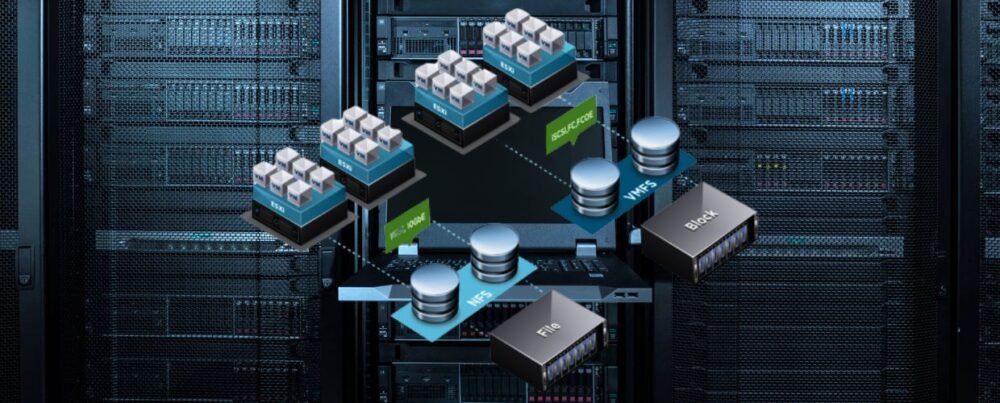Virtual storage is a vital component of modern computer systems that enables users to run multiple programs simultaneously and easily handle larger data sets. This article discusses Virtual storage’ importance, application, benefits, and limitations.
What is virtual storage?
Virtual storage, also known as virtual memory, is a technique used to expand the available memory by temporarily moving data from Random Access Memory-ram (RAM) to a hard drive or another secondary storage device. It allows the computer to run programs that require more memory than is physically available in RAM.
The operating system divides memory into fixed-size blocks called pages in a virtual memory system. When a program requests memory, the operating system assigns it a certain number of pages in RAM. If the program tries to access more memory than is available in RAM, the operating system swaps out some of the pages from RAM to the hard drive, freeing up space for new pages. This process is called paging or swapping.
Virtual storage is important because it allows programs to operate with more memory than is physically available in RAM, improving performance and allowing more complex programs to run on a computer.
Why is virtual storage important?
The virtual solution is an essential component of modern operating systems, as it allows computers to run more programs more efficiently and with greater capacity than would otherwise be possible. Some importance is given below.
Increases available memory
The virtual solution allows programs to use more memory than is physically available in RAM. It means that even if a computer has limited RAM, it can still run programs requiring a lot of memory. Virtual storage increases the available memory of a computer by using hard drive space as an extension of the physical RAM, allowing programs to use more memory space than is physically available in RAM.
Enhances performance
Virtual storage enhances performance by enabling a computer to access more memory, meaning it can run more programs simultaneously without slowing down. It allows the computer to use hard drive space as an extension of physical RAM, which is faster and more efficient than accessing data from slower RAM. The virtual solution improves modern computers’ performance and multitasking capabilities.
Supports multitasking
Virtual storage supports multitasking by allowing a computer to run multiple programs simultaneously. It allows a computer to open more programs simultaneously without closing one program before opening another. It is particularly important for modern computers, which run multiple programs simultaneously, such as web browsers, email clients, and media players.
Facilitates larger programs
The virtual solution facilitates larger programs by allowing them to utilize more memory than is physically available in RAM. It is particularly important for complex programs such as video editing software, which require large amounts of memory to function properly. Virtual storage allows larger programs to run smoothly on a computer without crashing or slowing down.
Application of virtual storage
Virtual storage is essential to modern computing, enabling users to run more complex applications and multitask more efficiently. Some importance is given below.
Multitask
The ability to multitask efficiently is a key advantage of virtual storage, and it has become an essential feature of modern operating systems. With the virtual solution, users can work more efficiently and productively without being limited by the physical memory available on their computers. Virtual storage allows modern operating systems to run multiple programs simultaneously, which is essential for multitasking.
Large applications
A virtual solution is essential for running large applications on modern computers, enabling users to work with larger data sets and more complex software without being limited by the amount of physical memory available on their computers. Virtual storage makes it possible to run large, complex applications such as video editing software, which require large amounts of memory to function properly.
Resource management
It is an important tool for managing computer resources. By allocating memory as needed, virtual storage ensures that programs can access the resources they require without wasting memory on programs that are not in use. It is an essential tool for resource management on modern operating systems, enabling efficient allocation of memory resources and preventing memory wastage.
System stability
Virtual storage is essential for maintaining system stability on modern operating systems, preventing crashes and freezes, and enabling efficient multitasking. It helps ensure the computer runs smoothly and efficiently, even when running multiple programs simultaneously, by providing a reliable and efficient way to manage memory resources.
Benefits of virtual storage
Some specific benefits of this include:
Ability to run more programs simultaneously
With more available memory, the computer can run more programs simultaneously without experiencing slow-downs or crashes. When virtual storage is used effectively, it can reduce the need for expensive physical memory upgrades, saving money on hardware costs. It allows the computer to use the hard drive to extend physical memory, increasing the available memory for running programs.
Faster performance
Programs can access memory more quickly when available, leading to faster execution times and a more responsive system. Virtual storage enhances system performance and responsiveness by enabling more programs to run simultaneously without slowing down the computer. It enables the computer to run multiple programs simultaneously, allowing users to switch between tasks more efficiently.
Ability to work with larger data sets
Large data sets can be stored in memory more easily when there is more available memory, allowing users to work with larger and more complex data sets. Virtual storage can improve file access times by caching frequently accessed data in memory. It can be used to increase the scalability of a system, allowing it to handle more users or larger data sets.
Improved system stability
When the computer operates out of physical memory, it can become unstable and prone to crashes. The computer is less likely to experience these stability issues by providing additional memory through virtual storage. It helps prevent crashes and freezes by swapping data from RAM to the hard drive when physical memory is full, ensuring that the computer always has access to the memory it needs.
Limitation of virtual storage
Virtual storage also has some limitations, including:
Slower performance
When virtual storage extends memory, programs may run more slowly than physical memory alone since data must be swapped between the hard drive and RAM. The virtual solution can also increase disk usage and reduce slowing down disk-related tasks like file transfers or system backups. This increased disk usage can also cause the hard drive to wear out more quickly, potentially leading to data loss or system failure.
Reduced battery life
Another limitation of virtual storage is that it can reduce battery life on laptops and other mobile devices. When virtual storage is used, the operating system may need to access the hard drive more frequently, which can consume more power and reduce battery life. The virtual solution can reduce battery life by increasing disk usage on laptops and other mobile devices.
Increased risk of data loss
Virtual storage increases the risk of data loss or corruption in a system crash or power failure. Data is regularly swapped between RAM and the hard drive when virtual storage is used. The transferred data may become corrupted or lost if the system crashes or loses power during a swap. If the computer crashes or loses power while data is being swapped between RAM and disk, there is a risk of data loss or corruption.
Increased complexity
Virtual storage can add complexity to the system, requiring more management and configuration than a system with only physical memory, and the virtual solution is the increased complexity it adds to the system. Virtual storage requires the operating system to manage and allocate physical and virtual memory, which can be complex and resource-intensive. It can increase system overhead and reduce performance, especially on older or less powerful systems.
Conclusion
Virtual storage remains an essential component of modern computing, enabling users to handle complex tasks and run multiple programs simultaneously. It allows the operating system to extend the available memory beyond what is physically installed by swapping data between RAM and the hard drive. Virtual storage offers numerous benefits, including increased available memory, support for multitasking, enhanced performance, and the ability to handle larger programs and data sets. It is used in various applications, from running large-scale scientific simulations to handling complex databases and virtual machines. Virtual storage is not without its limitations. It can impact system performance, reduce battery life on mobile devices, and add complexity to the system. Data loss or corruption in a system crash or power failure is risky and can significantly affect users and organizations.










